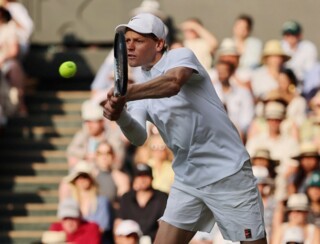At Wimbledon
William Skidelsky
People often reach for machine-based metaphors when describing the way Jannik Sinner plays tennis. If his game isn’t ‘metronomic’, it’s ‘laser-like’ in its precision. To watch the world number one at his best, Jonathan Liew wrote in the Guardian last month, ‘is like watching a hydraulic excavator very methodically demolishing a bridge’. While there’s no denying that Sinner is astonishingly consistent, both during a match and across whole seasons, what struck me on Centre Court last Sunday was how unmachinelike he often appears – especially when not actually hitting the ball. Between points, he shuffles around the court, as if worried that his hips are about to seize up. His service motion looks awkward at first – the legs and arms seem to move in contrary directions – before snapping into fluency at the point of contact. Sinner often seems engaged in a battle to keep a certain flailing inelegance in check. That he does so successfully is one of the marvels of his game.
Ahead of Sunday’s final, there were grounds for thinking that Carlos Alcaraz would prevail, as he had the previous five times they’d played – including, improbably, in Paris last month, when Alcaraz saved three match points in the fourth set and snatched victory in an extraordinary fifth-set tie-break. A narrative was starting to develop, about Alcaraz’s wayward genius – the drop shots and retrieving skills, the capacity to raise his game at key moments – being the one thing that could disrupt Sinner, who’d been at his ruthless best in dispatching Novak Djokovic in the semifinal. (There were shades in this of an earlier narrative about the impact of a young Nadal on Federer.) When Alcaraz won the first set on Sunday, coming back from a break down and clinching it with a lunging backhand that only just made it over the net, with Sinner marooned outside the tramlines, having hit what he assumed was a forehand winner, it seemed that this narrative would play out once again.
It didn’t though. Alcaraz lost focus after winning the set, and Sinner immediately broke. And from then on, he shut up shop on his serve, facing only three more break points in the rest of the match. With Sinner serving for the second set at 5-4, Alcaraz, predictably, raised his game. Putting noticeably more effort into his groundstrokes, he struck the ball with immense power, landing it deep in the corners. No other player would have withstood such a barrage, but this time Sinner was ready, and proved he has a higher level too. When Alcaraz forced him out wide, and hit a drop volley into the open court, Sinner surged forwards and flicked a cross-court backhand winner. Moments later he struck a down-the-line forehand winner at full stretch, before capping a set point of breathtaking quality with another outlandish forehand.
Alcaraz is a player of dashes, of surges. He lies low for long periods, often playing quite scrappily, but gathers himself for the crucial moments. An Alcaraz victory is rarely cumulative; it tends to turn on one or two blazingly brilliant passages, a few impossible shots – shots he uses to whip up the crowd, who urge him on to further feats of excellence. The key to beating Alcaraz, then, is to cut off the sources of his inspiration, to keep him in pent-up, low-energy mode. And that is what Sinner did so magnificently on Sunday. When Alcaraz hit his most aggressive forehands, Sinner responded with even harder groundstrokes of his own. He stayed close enough to the baseline to get to Alcaraz’s drop shots with ease, forcing Alcaraz to reduce his margins, which led him to land several in the net. For possibly the first time in his career, Alcaraz found himself subdued, blunted, perhaps doubtful that his best was good enough.
I am an Alcaraz fan, and desperately wanted him to win in Paris. At Wimbledon, though, I couldn’t help but admire not only the quality of Sinner’s ball-striking, but the tactical masterclass that was unfolding. The rest of the crowd seemed to feel this too; there was less support for Alcaraz than I expected. Sitting a few seats along from me were an Italian couple in their fifties who were cheering for ‘Jannik’. The man told me during a set break that they’d also been at Roland Garros, where the crowd had been staunchly pro-Alcaraz – not like at Wimbledon, he said, where ‘people know their tennis’. When Sinner won the match, I exchanged glances with the man, and he gave me a satisfied nod.
